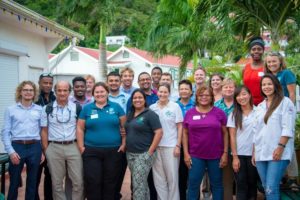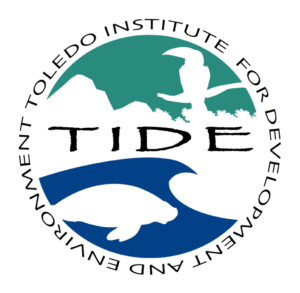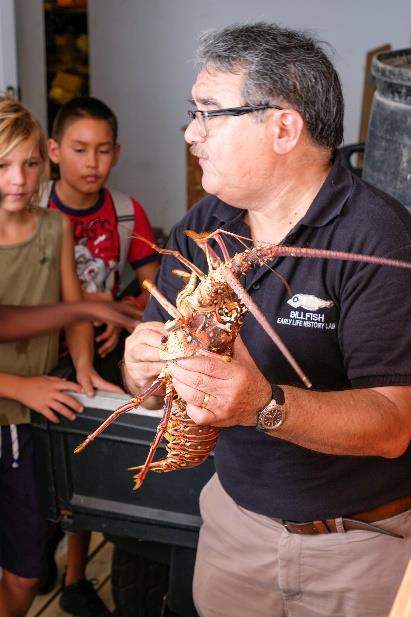 Saba, October 5, 2018 – Representatives from 15 Caribbean marine national parks recently met on the island of Saba in the Caribbean Netherlands to focus on their role in contributing to sustainable fisheries.
Saba, October 5, 2018 – Representatives from 15 Caribbean marine national parks recently met on the island of Saba in the Caribbean Netherlands to focus on their role in contributing to sustainable fisheries.
Hosted by the Saba Conservation Foundation, this regional gathering included park managers from Saba, Sint Eustatius, Bonaire, the British Virgin Islands, the Turks & Caicos Islands, Honduras and Belize. The park managers were joined by fishers, fisheries policy advisors and fisheries data officers from Bonaire, Saba and Sint Eustatius, plus fisheries scientists from the US and Mexico, and regional NGO and academic partners.
Marine protected areas (MPAs) are an important tool in fisheries management. Large, multi-use MPAs such as the Saba Bank National Park, Cayos Cochinos Marine Natural Monument in Honduras and Port Honduras Marine Reserve in Belize play a key role in ensuring sustainable local fisheries harvests.
Mrs. Celia Mahung, Executive Director of the Toledo Institute for Development and Environment comments: “In Belize, fishers are allocated specific fishing areas, based on historical use, and they also have access to deep water fishing. MPA co-managers work on creating awareness of regulations and ensuring compliance to build sustainable fisheries for future generations.”
“We cannot do this on our own”, says Mrs. Mahung. “Fishers in turn help us by recording catch data, and a combination of local knowledge and science is used in adaptive management for commercial species. MPA managers, leaders of fishing organizations and international partners work with the Belize Fisheries Department to make sound decisions about sustainable levels of catch and to ensure the implementation of best practices for wise fisheries management,” she explains.
Smaller marine protected areas also have an important role to play in ensuring healthy local reef fish populations through the implementation of no-take fisheries regulations, such as in Saba National Marine Park, Statia Marine Park and Bonaire National Marine Park. These parks support valuable tourism industries associated with diving and snorkelling. They also contribute to sustainable fisheries by protecting large and highly reproductive fish within park boundaries, whose young then spill over into surrounding fishing areas.
Statia Marine Park Manager, Ms. Jessica Berkel, explains: “Our marine parks bring about positive benefits for tourism and for fisheries, but as managers we face many challenges. Effective enforcement is needed to ensure that fish can grow and reproduce, and to ensure protection of the largest, most fertile fish and lobsters. In some parks, pressure from recreational fishing can be high but goes unmonitored. Meaningful communications with park users and dynamic education programs for youth are essential.”
“By exchanging ideas and sharing expertise with other managers we can keep pace with advances in fisheries management in the region, such as new enforcement strategies and technology, and community programs for research and monitoring. We can see how to better support monitoring and management actions to protect coral reef ecosystems in our own parks.”
Parks Manager at the Saba Conservation Foundation, Mr. Kai Wulf, comments about the meeting: “We’ve gained new insights into fisheries biology, ecology and management strategies from top regional fisheries scientists. Visiting Mexican lobster specialist, Dr. Eloy Sosa Cordero, was impressed by the fisheries data we’ve collected on Saba and was enthusiastic about the opportunity we have to apply this data to inform sustainable fisheries.”
“In other countries, fishers and MPA managers have participated in field visits to learn about sustainable fishing practices and share management experiences. Such exchanges, plus small project funding, technical support and sharing of monitoring findings with fishers and communities are among the next steps we look forward to taking,” commented Mr. Wulf.
Making the most of the visitors on-island, the Saba Conservation Foundation Junior Rangers participated in a hands-on lobster session with Dr. Sosa Cordero. Some faced their fears and got up close with live lobsters. Others learned what it’s like to work as a marine biologist and lobster researcher. They all learned fun facts about the life cycle of lobsters and their distribution throughout the Caribbean.
The meeting was an initiative of the MPAConnect Network which is comprised of marine protected areas in 10 Caribbean countries and territories, working in partnership with the Gulf and Caribbean Fisheries Institute and the US National Oceanic and Atmospheric Administration’s Coral Reef Conservation Program, with funding from the US National Fish and Wildlife Foundation. Six regional MPAConnect learning exchanges have been held to date, each bringing together MPA managers from around the Caribbean to share experiences and discuss best practices relating to priority management themes such as marine law enforcement, protected area financing, coral reef monitoring, and MPA outreach and education programs. For more information please contact [email protected]
 Participants in the peer-to-peer learning exchange on fisheries management for Caribbean MPA managers (Photo: K. Wulf)
Participants in the peer-to-peer learning exchange on fisheries management for Caribbean MPA managers (Photo: K. Wulf)
Junior Rangers learning about lobster with Dr. Eloy Sosa Cordero (Photo: B. Janssens)
About the Gulf and Caribbean Fisheries Institute (GCFI): When the Gulf and Caribbean Fisheries Institute was founded in 1947, the riches in our seas appeared limitless. Originally GCFI helped develop new ways to exploit the region’s marine resources and to develop new fisheries based upon this perception of an inexhaustible sea. However, it wasn’t long until the degradation of marine resources and threats to regional fisheries were documented. GCFI now works to advance the goals of sustainable use, wise management, conservation, and restoration of fisheries in the region. GCFI provides a platform for the exchange of information and perspectives among decision-makers, scientists, managers, educators, resource users, and students. For more information please visit www.gcfi.org

